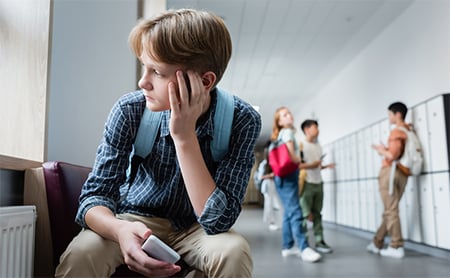Addressing the Youth Mental Health and Loneliness Crises Through Social Connection in Schools
July 31, 2023 | Heather Sebero
 Young people in the United States are experiencing a mental health and loneliness crisis. The epidemic of loneliness and isolation is a major public health concern. Although youth mental health conditions were on the rise before 2020, the COVID-19 pandemic accelerated this trend. This blog post examines the youth mental health and loneliness crises and shares guidance for how public health agencies can work alongside schools to address these crises through social connection.
Young people in the United States are experiencing a mental health and loneliness crisis. The epidemic of loneliness and isolation is a major public health concern. Although youth mental health conditions were on the rise before 2020, the COVID-19 pandemic accelerated this trend. This blog post examines the youth mental health and loneliness crises and shares guidance for how public health agencies can work alongside schools to address these crises through social connection.
Recently, U.S. Surgeon General Vivek Murthy, MD, MBA, released an advisory raising the alarm on Americans’ soaring social isolation and loneliness rates—today, loneliness is more widespread than other major health issues. The lack of social connection poses a significant risk to the health and well-being of all individuals. However, these impacts are felt most acutely by people who are marginalized because of their race, age, income, location, sexual orientation, and gender identity.
Young people and people with poor mental health experience higher rates of loneliness and isolation. Moreover, loneliness and social isolation among youth increase the risk of depression, anxiety, and suicide. The lack of social connection also exacerbates the continued stigma associated with talking about mental illness and suicide. This is especially concerning because, in recent years, there have been significant increases in certain mental health conditions in youth, including depression, anxiety, and suicidal ideation.
A public health approach to these dual crises includes addressing the multiple factors that influence mental health and loneliness as well as engaging multiple sectors, such as community-based organizations, health care systems, and schools. Although each sector has a role to play in promoting greater connection, schools are well-positioned to reach youth by improving the quality of relationships they experience. Public health agencies and schools can develop ways to consistently and regularly assess social connection while also working together to develop, implement, and evaluate sustainable practices. Additionally, public health agencies can provide funding or other environmental and data strategy support to schools to enhance their social connection strategies.
School connectedness is defined as the belief by students that adults and peers in their school care about their learning as well as about them as individuals. School connectedness has been linked to positive health outcomes, including reduction in emotional distress, symptoms of poor mental health, and suicidal ideation. School connectedness has also been identified as a protective factor for adolescents who might be facing stress, adversity, or marginalization.
The Youth Risk Behavior Survey found that three in five U.S. high school students felt connected to others at school. The prevalence of feeling connected to others at school was highest among male, Asian, and heterosexual students. Youth who have experienced racism at school, identify as LGBQ+ (this report does not highlight data specifically on students who identify as transgender because the 2021 Youth Risk Behavior Survey did not have a question assessing gender identity), and are marginalized because of their overlapping social identities (i.e., youths who hold minority racial, ethnic, and sexual identities) felt the least connected to others at school.
School Connectedness Practices
Assess Policies to Ensure a Lack of Discriminatory Practices
Schools can play a critical role in promoting students’ wellbeing by creating environments where all students feel that they are cared for, supported, and belong. Establishing safe and supportive schools for adolescents involves creating an antidiscriminatory environment. Schools can proactively address discrimination by ensuring that all students are treated fairly and justly. All students should have access to spaces free from discrimination, including harassment, bullying, intimidation, and violence. For example, schools can analyze school disciplinary policies to ensure that they are being implemented equitably across racial and ethnic groups.
Implement Social and Emotional Learning Skill Development
To promote positive school climates, schools can implement schoolwide programs such as those focused on social and emotional learning. These programs develop and strengthen communication and problem-solving skills, emotional regulation, conflict resolution, and coping skills in youth. Through social and emotional learning programs, young people can learn how to understand their emotions, show empathy toward others, and develop decision-making skills. Social and emotional learning programe align with young people’s understandings and definitions of mental health and well-being.
Promote Healthy Peer Norms
Another way schools can foster school connectedness is to promote healthy peer norms. This approach seeks to normalize protective factors for mental health, such as help-seeking, reaching out, and managing emotional distress. Schools can promote healthy peer norms through peer support programs. Peer support programs connect youth with mental health conditions, with peers that have a similar lived experience and can facilitate a sense of connectedness and belonging.
Youth are experiencing multiple mental health crises, and public health agencies and schools are well-positioned to help. Public health agencies and schools can work together in developing systems to track social connection and evaluate school-based practices. Schools can support the health and development of all students by intentionally focusing on students with marginalized identities. To be effective, schools should also offer programs that students want and trust. Public health agencies can support schools to advance school connectedness and reduce the stigma that surrounds talking about mental health by funding, implementing, and assessing the practices outlined in this blog post.